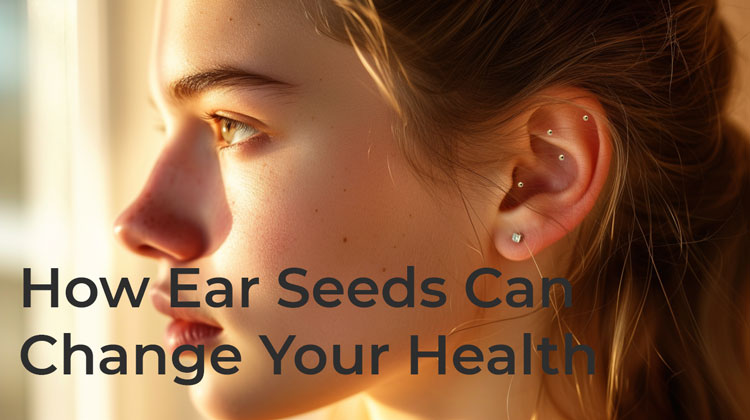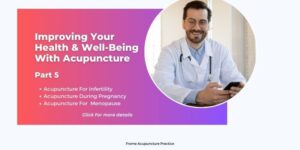Ear Seeds: Ancient Science Meets Modern Medicine
Ear seeds have become an intriguing new wellness tool, with tiny seeds placed carefully on the ear to stimulate healing pressure points. Rooted in ancient Traditional Chinese Medicine (TCM) and more contemporary discoveries, these seeds offer an accessible, natural way to promote whole-body equilibrium. From chronic pain to insomnia, hormone balance to addiction recovery, a growing body of research shows ear seeds may relieve stress and resolve symptoms without side effects.
An Overview of Ear Seeds: Origins, Claims and Basics
Ear seeds are part of a holistic healing approach known as auriculotherapy or ear acupressure – applying stimulation to acupuncture points on the ear in order to restore energy flow and organic balance. The approach draws from core TCM concepts of qi (vital energy) travelling through meridian pathways. Blockages or disturbances in qi may manifest as illness or pain elsewhere in the body.
The earliest records of auriculotherapy date back to ancient China over 2,000 years ago. However, French neurologist Dr Paul Nogier brought renewed attention by mapping over 200 acupoints on the ear that connect to specific organs and bodily systems. His work formed the basis of modern auriculotherapy practised today.
Small round seeds or tiny metal balls attached to hypoallergenic adhesive stickers are carefully placed on targeted points of the outer ear. Traditionally, herbs like vaccaria seeds were used, but gold, silver and crystal ear seeds have become popular, too. Gentle massaging stimulates the acupoints, with subtle motion sending signals to the brain to activate natural healing processes.
Proponents claim the non-invasive seeds bring drug-free relief to conditions like chronic back pain, migraines, arthritis, anxiety, insomnia, digestive complaints and more by correcting energy imbalances. The simplicity of seeds stuck on the ears empowers people to self-care without needles or trips to the doctor.
Understanding How Ear Seeds May Work: The Science
Several theories help explain why ear seeds help some people feel better. But much remains scientifically unknown about the exact mechanisms at play.
Viewed under the paradigm of TCM, health relies on the orderly flow of qi energy along meridian channels mapped throughout the body – including in the ears. When operating optimally, qi nourishes organs and provides vitality. But various stressors like poor diet, toxicity or emotional turmoil can cause qi to become stuck or depleted. Auriculotherapy clears obstructions so everything can realign.
Western medicine instead focuses on the complex neural networks hidden inside the ear. The stimulation of acupoints activates nerves that communicate with the brain via the vagus nerve and cranial nerves. In response, the brain releases natural chemicals like endorphins and serotonin to alter pain perception, reduce inflammation, improve mood and regulate nervous system signals.
Ear seed micro-movements may also distract the brain from processing pain sensations as strongly, raising someone’s pain threshold. The continuous pressure could impact limbic system areas that influence stress, emotions, hormones and immunity. We need more research to pinpoint what makes this alternative method so helpful for numerous people.
Applying Ear Seeds: Technique Tips and At-Home Care Basics
Getting started with ear seeds requires first consulting a licensed acupuncturist or integrative medicine practitioner. They will assess your health goals and determine which auricular points correspond best, carefully placing the tiny seeds for maximum results.
- Where ear seeds go depends on the symptoms being treated. Specific locations tie into joint pain relief, digestive complaints, addiction support, menstrual issues, headaches and more. Precision matters.
- Seeds usually stay in place for 1-2 weeks if cared for properly. Follow your practitioner’s advice on changing and massaging them.
- Wash hands before touching ear seeds. Rotate them a few circles whenever you think of it – 3 to 5 times daily works well.
- Sensitivity and mild soreness are normal initially. But remove immediately if significant pain or oozing occurs, indicating possible infection.
- Allow the ear skin to rest before reapplying a fresh set. Never dig around trying to take out the tiny seed if it falls off the sticker into the ear canal – seek medical assistance.
Growing consumer interest has led to home ear seed kits for self-guided placement. But learning directly from a skilled healing arts professional ensures correct auricular point selection and safe handling.
Reviewing the Research: Ear Seeds Benefits and Effectiveness Data
Medical research on ear seeds remains in its early stages, often constrained by small sample sizes or a lack of standardized protocols. However, promising studies connect auriculotherapy with measurable improvements in some common health complaints:
- <span data-preserver-spaces="true">Chronic lower back pain</span> intensity decreased by 75% for nearly 3/4 of participants in one clinical trial. Pain-linked disability scores also significantly dropped.
- Rigorous experiments found acupuncture plus ear seeds more effectively reduced <span data-preserver-spaces="true">osteoarthritis knee pain</span> than control groups up to a year later.
- Hospital patients receiving auricular acupressure reported 50% less pain intensity on average post-surgery compared to regular care. Their pain meds usage also declined.
- College students with high anxiety did cognitive tests with fewer mistakes after true ear seed treatment versus sham placebo seeds. Significant reductions happened in both mental anxiety and physical stress biomarkers.
- Reviewing 15+ years of data, the UK’s National Institute for Health and Care Excellence (NICE) now promotes acupuncture as a chronic pain adjunct therapy option covered by national healthcare plans. Ear seeds qualify under protocols.
The cumulative results argue ear seeds are a safe, low-cost complementary approach for people struggling with pain or anxiety issues. More rigorously controlled clinical trials in the pipeline should add to knowledge about optimal practices.
Are Ear Seeds Safe? Understanding the Risks and Side Effects
When properly selected and applied, ear seeds pose minimal health risks for most adults. But some considerations apply:
- Monitor skin under seeds for redness or rashes, indicating possible irritation or infection. Remove immediately if this occurs. Those who are highly sensitive may tolerate silicone ear seed bases better than adhesive ones.
- If a seed somehow gets lodged deeper into the ear canal, don’t attempt removal. Seek medical help to prevent trauma, blockage complications or tissue damage from foreign body insertion.
- Feeling initial dizziness or fatigue means the ear seeds take effect. But extended exhaustion, nausea, or emotionally intense mood swings warrant checking in with your practitioner about the cause.
- Insufficient evidence exists demonstrating ear seeds safety for pregnant women. Exercise caution until more research results emerge.
Integrating professional guidance plus smart lifestyle adjustments maximizes ear seed therapy success without problems. Being patient through temporary amplification of symptoms before feeling better is part of the process.
Ear Seeds Takeaways: A Recap
In review, ear seeds offer a promising natural solution for rebooting health by way of precision acupoint stimulation. Results for chronic diseases often deemed “difficult to treat” compel medical providers to take notice. Committing to an initial ear seeds trial period while managing expectations seems sensible. Developing a partnership with an experienced acupuncture practitioner ensures proper application and follow-up support too. From addiction relapse prevention to better regulating menstrual cycles, ear seeds open up possibilities for taking some control back into your own hands.
FAQs About Ear Seeds
Q1: What are Ear Seeds? A1: Ear seeds are tiny seeds or balls placed on the outer ear. They’re a form of auriculotherapy, which focuses on acupressure in the ear. These seeds are based on principles of acupuncture and Chinese medicine and are meant to stimulate pressure points related to organs and bodily systems to promote healing and relieve symptoms.
Q2: What is the history of Ear Seeds? A2: Ear seeds have been part of Traditional Chinese Medicine for thousands of years. More recently, they are linked to the work of neurologist Dr. Paul Nogier. Traditionally, plant seeds like vaccaria were used, but now they can also be ceramic, metal, or crystals due to their rise in popularity.
Q3: How do Ear Seeds work according to Chinese medicine? A3: According to Chinese medicine, Ear Seeds work by facilitating the flow of qi or vital energy in the body. The ear is seen as a microsystem representing the whole body, and the seeds send signals to the brain to release healing chemicals.
Q4: What are the explanations from Western medicine regarding how Ear Seeds work? A4: Western medicine suggests that Ear Seeds work by applying gentle pressure on nerves and pressure points. This stimulation can trigger the release of natural endorphins, reducing pain. However, the exact mechanisms are still under research.
Q5: What conditions can Ear Seeds alleviate? A5: Ear Seeds may alleviate various conditions, including anxiety, stress, headaches, insomnia, IBS, chronic pain, back pain, arthritis, migraine, hormonal issues, weight loss, and addiction.
Q6: How are Ear Seeds placed and secured? A6: It’s best to have Ear Seeds placed by a trained professional. They’ll secure the seeds on points related to your symptoms using hypoallergenic tape.
Q7: How should I take care of Ear Seeds at home? A7: To care for Ear Seeds at home, gently massage them 3-5 times per day, replace the seeds every few days, and give your ears breaks between sessions.
Q8: What is the research on the efficacy and safety of Ear Seeds? A8: Research on Ear Seeds is limited but promising, particularly for pain and anxiety relief. However, many studies are small or of low quality, and more research is needed to understand the mechanisms better.
Q9: What are the potential side effects of using Ear Seeds? A9: Potential side effects include skin irritation and the risk of infection if seeds fall into the ear. Some users may experience dizziness, fatigue, or emotional releases. Pregnant individuals should avoid Ear Seeds without medical guidance.
Q10: How can I seek professional guidance when using Ear Seeds? A10: Start by consulting with an acupuncturist to ensure proper placement and technique. It’s also essential to check for any interactions with pre-existing medical conditions.
This article is brought to you by: Keith Ferris Acupuncture in Frome
The Article How Sticking A Seed On Your Ear Can Change Your Health First Appeared ON
: https://ad4sc.com
The Article How Sticking A Seed On Your Ear Can Change Your Health was found on https://limitsofstrategy.com




Comments are closed